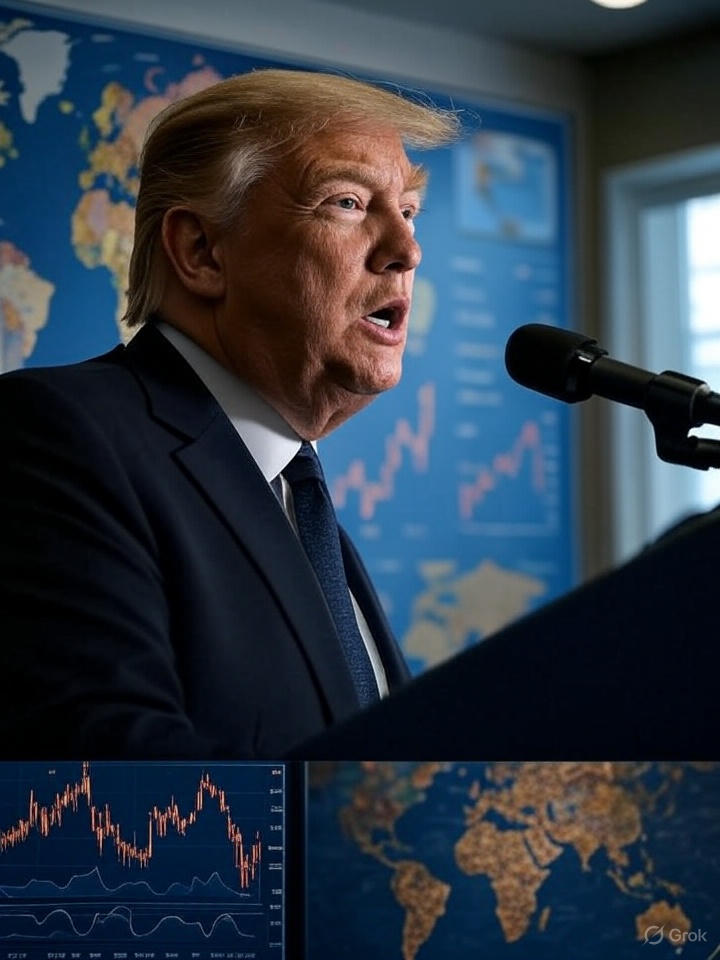President Donald Trump has once again made headlines by announcing strong new tariff policies in 2025. These changes are big and bold and they are shaking up global trade. In this blog let’s understand what tariffs are what Trump’s latest decisions mean how other countries are reacting and what this might do to the global economy.

What Are Tariffs?
Tariffs are taxes that a country puts on goods coming from other countries. For example if the U.S. places a 35% tariff on Canadian goods it means American buyers will have to pay 35% extra tax when they import products from Canada. Tariffs make foreign goods more expensive which can help local industries compete but they can also lead to price hikes and trade fights.
Trump’s 2025 Tariff Moves
President Trump has announced a new round of high tariffs. Here’s a quick look at the numbers:
- 35% tariff on goods from Canada
- 30% tariff on imports from Mexico and the European Union
- 15–20% blanket tariff on most other trading partners (still being considered)
These new tariffs are much higher than usual and have created major concern among businesses, investors and world leaders.
Why Is Trump Doing This?
Trump says he wants to protect American workers and companies. His view is that foreign countries are not trading fairly and that American companies are suffering because of cheap imports. By making foreign goods more expensive he hopes people will buy more American made products.
He also believes that tariffs will force other countries to renegotiate trade deals in Americas favor. This is not the first time Trump has used tariffs as a pressure tool he did something similar during his first term as president from 2017 to 2021.
Global Reaction: Tension Rising
Trump’s tariff actions have worried many countries. Let’s look at the early reactions:
- European Union (EU): The EU has delayed a decision on retaliatory tariffs. They were planning to impose tariffs on $24.5 billion worth of American products but are now waiting to see how talks develop. However they are not happy.
- Canada and Mexico: These close trading partners of the U.S. are feeling the heat. Their leaders have called Trumps actions “unfair and damaging” and they may respond with their own tariffs.
- Asia: Stock markets in Asia fell sharply after the news. Investors fear that global trade will slow down if big economies start fighting each other with tariffs.
How Tariffs Affect the Economy
Here’s what tariffs can do:
- Increase Prices for Consumers: If American companies have to pay more for foreign products they might pass the cost to consumers. That means higher prices at stores.
- Hurt Exporters: If other countries retaliate American companies selling abroad may face higher tariffs too. This could reduce their sales and profits.
- Slow Down Global Trade: If many countries start putting up trade barriers it becomes harder and more expensive to do business internationally. This could slow down the world economy.
- Short-term Gains Long-term Pain: While some industries (like steel or textiles) may benefit in the short term the overall economy could suffer in the long run due to less competition and higher prices.
Tariff Revenue: Is the U.S. Earning Big?
You might think the government makes a lot of money from tariffs. But the numbers tell a different story.
In May 2025 total tariff revenue in the U.S. was $526 billion. While that sounds like a big number it’s still a small share of the U.S. government’s total income. Most revenue still comes from taxes on income, businesses and social security. Tariffs are just a small slice of the pie.
Also remember: most of the cost of tariffs is paid by American importers not the foreign companies. This means American businesses and consumers bear much of the burden.
Impact on Stock Markets
Financial markets reacted quickly:
- Asian stock indices fell after the announcement with investors fearing a global trade war.
- U.S. markets showed mixed signals—some American manufacturing companies saw their stock prices rise but many tech and global companies faced losses.
- Currencies of countries affected by the tariffs like Canada and Mexico also saw some weakness.
What Could Happen Next?
Here are a few possible outcomes in the coming months:
- Trade Negotiations: Other countries may come to the table and try to cut deals with the U.S. to avoid further tariffs.
- Retaliation: Countries like Canada, Mexico or EU members may respond with their own tariffs sparking a back-and-forth tariff war.
- Legal Challenges: Some U.S. companies or trading partners might challenge the tariffs under World Trade Organization (WTO) rules.
- Public Pressure: If prices go up in American stores and farmers or exporters get hurt, pressure may build on Trump to ease the tariffs.
Final Thoughts: Risks and Uncertainty
Trump’s tariff moves are bold and risky. Supporters say these actions protect American jobs and force foreign nations to play fair. Critics argue they create uncertainty, hurt global trade and raise prices for everyone.
Only time will tell if these policies help or hurt the U.S. economy. What’s clear now is that we are entering a new chapter in global trade—and the world is watching.
Key Takeaways
- Tariffs are taxes on imports. Trump has announced big new ones in 2025.
- Canada, Mexico, and the EU are major targets, with talks of more to come.
- Global markets are nervous, and the risk of a trade war is growing.
- Tariff revenues are increasing but are still a small part of the U.S. budget.
- The impact on consumers, exporters, and international relations could be big.
